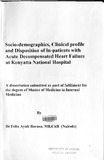| dc.contributor.author | Barasa, Felix A | |
| dc.date.accessioned | 2013-05-25T06:51:14Z | |
| dc.date.available | 2013-05-25T06:51:14Z | |
| dc.date.issued | 2009 | |
| dc.identifier.citation | Master of Medicine in Internal Medicine, The University Of Nairobi, 2009 | en |
| dc.identifier.uri | http://erepository.uonbi.ac.ke:8080/xmlui/handle/11295/25546 | |
| dc.description.abstract | Background
Heart failure is a major clinical and public health problem worldwide due its high
morbidity and mortality. It is a disease of the elderly in the developed countries. Valuable
information concerning its epidemiology, clinical and laboratory characteristics is scanty
in Africa in general and Kenya in particular. We conducted a study to determine the
prevalence and evaluate the socio-demographics, clinical characteristics and disposition
of in-patients with acute decompensated heart failure at Kenyatta National Hospital - a
tertiary medical centre in Nairobi, Kenya.
Objective
To determine epidemiologic features, clinical profile and non- pharmacological level of
care in heart failure patients admitted at Kenyatta National Hospital.
Design
Prospective Clinical observational register of patients admitted with acute
decompensated heart failure over a period of six months.
Setting
Medical wards at Kenyatta National Hospital, Nairobi, Kenya.
Subjects
Two hundred and eighty six patients aged thirteen years and above admitted with acute
decompensated heart failure. Diagnosis was based on the Modified Framingham Clinical
Criteria for the Diagnosis of Heart Failure.
Results
A total of 5,043 patients were admitted into the medical wards over the six months period
(December 2007- may 2008). Of these, 458 patients were screened and 286 recruited
giving a prevalence of 5.7%. Female comprised 53.8% and males while 46.2%. The mean
age was 44 years. Their districts of birth and residence over the past 5 years were mainly
Nairobi and Central Kenya (province) districts. Two hundred and five (71.6%) had
attained none or only primary education. One hundred and four (54%) were married
(54%) and 111 (39.9%) were employed. Eighty five of the (29.7%) had history of
alcohol consumption while 66 (23.2%) had history of tobacco smoking. Two hundred and
sixty nine patients (94.2%) were admitted in NYHA functional classes III and IV. The
mean haemoglobin level was 12.92g/dl while their median creatinine was 97micromoll1.
The mean serum sodium concentration was 137 mmolll, with 102 (35.8%) having
Hyponatriema. The mean serum potassium concentration was 4.8mmo1l1. The
commonest radiological findings were cardiomegally (97.3%) and alveolar oedema
(81.4%). Non pharmacological treatment was poorly offered. In-hospital mortality was
10.8%.
Conclusion
The six month period prevalence of acute decompensated heart failure in medical inpatients
at KNH was high at 5.7%. Both sexes were affected equally. It is a disease of all
age groups with a peak in the 20-40 year age bracket. Majority of patients were admitted
with NYHA class III and IV symptoms and were fluid overloaded. Non pharmacological
modes of therapy offered at discharge were significantly sub-optimal. | en |
| dc.language.iso | en | en |
| dc.publisher | University of Nairobi. | en |
| dc.title | Socio-demographics, clinical profile and disposition of in-patients with acute decompensated heart failure at Kenyatta National Hospital | en |
| dc.type | Thesis | en |
| dc.description.department | a
Department of Psychiatry, University of Nairobi, ; bDepartment of Mental Health, School of Medicine,
Moi University, Eldoret, Kenya | |
| local.publisher | Faculty of Medicine | en |

